Start the Presses
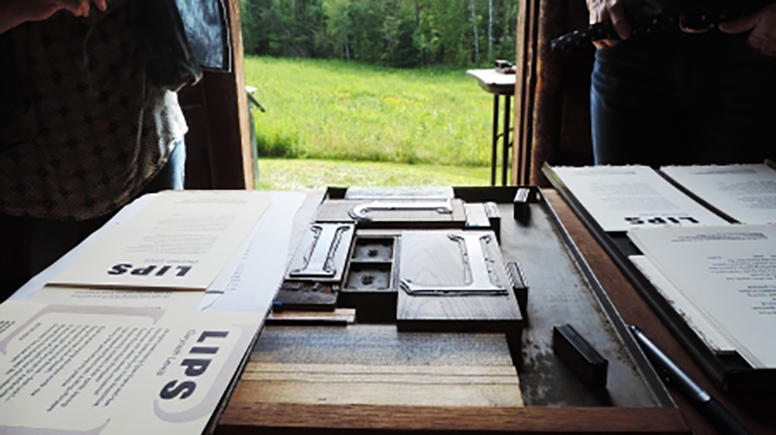
Start the Presses
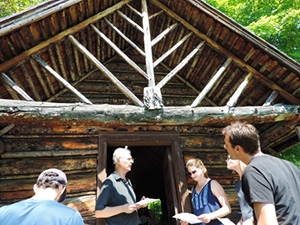
In 1939, Robert Frost urged members of the Bread Loaf community to set poems by hand as a means of enhancing the relations among poets, readers, and scholars, and in the years that followed Bread Loaf obliged, starting the Bread Loaf Printers. In 1952, Frost spoke with author Bela Kornitzer at the Homer Noble Farm in Ripton, on topics ranging from nature and politics to liberty and courage. At the end of the interview, Frost identified the ability to be original and to take initiative as the greatest of freedoms, claiming that “freedom lies in being bold.” Fittingly, the first prints made on the newly restored letterpresses at Middlebury’s Bread Loaf campus, Frost’s second home, featured this quotation.
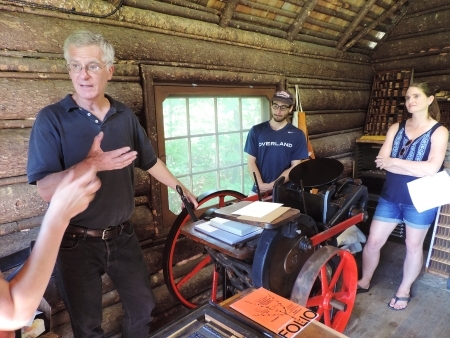
The effort to breathe new life into Bread Loaf’s presses—hidden for years under accumulated debris and dust in the Printer’s Cabin—highlights the profit a community can yield from bold initiative, original thinking, and devoted partnership. The idea of reanimating the long-dormant presses itself came to life during the 2016 session of the School of English and quickly became a collaborative effort supported enthusiastically by Bread Loaf administrators, faculty, students, and graduates; the heads of the Writers’ Conferences and Middlebury’s Special Collections; and other Middlebury constituencies, including President Laurie Patton.
Spearheaded by Claudia L. Johnson, Bread Loaf faculty member and director of the letterpress project, the initiative gained traction as Middlebury restored electricity to the cabin. Bread Loaf graduate and historian Mark Wright MA ’89 supervised the first round of cleaning. Local printers Heather Hale ’77, John Vincent, and Sally Foster assessed acquisition needs and committed their energies to reconditioning the presses. Members of the Bread Loaf theater, facilities, and administrative staff jumped in to lend a hand, help grind the treadle, build needed shelves, and store unneeded type and mechanical parts.
“Setting up a new shop takes time,” Hale explains. “There are many pieces to procure: type and type cabinets, galley trays, spacing, leading and leading cabinet, composing sticks, chases, quoins, paper and press packing, line gauges, ink, ink plates… . We are still collecting, but we’re almost there.”
Built in 1896 by Joseph Battell, the diminutive but handsome and idyllically situated log Printer’s Cabin originally printed menus for his inn. The Middlebury archives hold samples of theater and Commencement programs, poems, and bookplates created under the imprint of the Bread Loaf Press from the inception of the Bread Loaf School of English in 1920 until about the 1960s, when the presses were moved or sold. In the late 1980s, a Bread Loaf School of English and Princeton professor, John Fleming, donated the machines that now reside in the cabin—a Chandler & Price platen press and a Vandercook 17-cylinder proof press—and for a time he headed up printing at Bread Loaf.
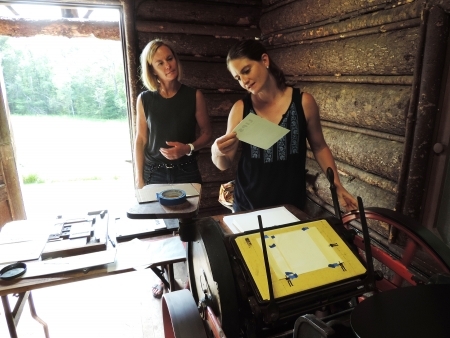
“Bread Loaf is a perfect spot for a print shop,” Hale says. “There is a love of words.”
This summer Bread Loaf students and faculty participated in two letterpress workshops, one (before the Printer’s Cabin was ready) led by Hale, Vincent, and Foster at Hale’s shop in Stowe and the other led by printer David Sellers of Pied Oxen Printers in New Jersey in the Printer’s Cabin itself. Participants learned the intricacies of design, paper, ink, and type choices as they made prints of two poems by faculty member Gwyneth Lewis.
These activities have seeded other letterpress activity and ideas, on and off the Bread Loaf campus. During the academic year, Johnson enlisted Sellers to run an intensive letterpress workshop, open to graduate students and faculty, at her home institution of Princeton. “Having set poetry by hand, I am now much more aware of the depth and dimensionality of poetry, its weight and substance.” Letterpress, she says, “enhances the sensuousness and power of texts.”
Now that the presses are operational, students across all of Middlebury’s programs will enjoy the creative freedom of setting their voices to type. Bread Loaf faculty are planning to integrate the newly available printing resources into their courses in summer 2018. And Johnson is arranging weekly workshops across the session.
Michael Collier, the former director of the Writers’ Conferences, says that a working letterpress “will add to the discussion of publication in an immediate and physical way that I find very exciting. Writers will once again get to smell ink, feel the weight of type and the texture of paper, and hear the press as it reverberates in the Printer’s Cabin. In the future, the conferences can invite letterpress and art book printers to come and talk about their work and offer workshops.”
Rebekah Irwin, director of Special Collections, imagines workshops for the undergraduate population that center on the art of the book. “Letterpress printing speaks to many disciplines: design, craftsmanship, math, mechanics,” Heather Hale says. “It is satisfying on the deepest level to think of something you want to communicate, put the form together, print it, and immediately have it in hand.”
John Vincent, founder of A Revolutionary Press, says his interest in the project is motivated by the collective energy of the many who have been involved. When the presses first ran again on August 1, 2017, he contributed the Frost quotation, a gem he had used for a series of bookmarks he printed in collaboration with the Vermont Book Shop for Independent Bookstore Day. His eyes light up when he describes uncovering the origin of the quote and its suitability to the Bread Loaf Printer’s Cabin project. It’s the same animation that has fueled those who have already contributed their efforts, that will mark the faces of those who use the presses in the future, and that now enlivens the wheels and rollers of Middlebury’s restored letterpresses.
Q & A with Claudia Johnson
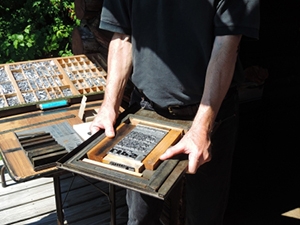
Q. How did you work together with the Writers’ Conferences and Special Collections to make the restoration possible? Or did they contribute more in terms of their support for the idea of the project?
A. Restoring the Printer’s Cabin required a lot of steps. The idea ignited at Bread Loaf. But we immediately realized that the project was bigger than the Bread Loaf School of English alone. A little research showed that the Printer’s Cabin housed the only printing presses at Middlebury and that restoring the Printer’s Cabin would benefit a larger Middlebury/Bread Loaf community. We reached out to the Bread Loaf Writers’ Conferences and to Special Collections, and they immediately offered their support. Because we made such a strong case that a fully operational Printer’s Cabin satisfied the curricular needs of many constituencies, Middlebury agreed to bring electricity to the cabin, and this enabled us to move forward with our project.
Q. What kind of input/work was necessary to get the presses running again?
A. First, we needed to clear out and clean out the cabin, which had accumulated about 20 years of junk, dust, and animal droppings. We had to figure out exactly what equipment we had, what could be salvaged, what needed to be tossed. Rotten rubber press rollers, for example, and cans of cruddy, encrusted, unsorted lead type had to go. Then we turned to the actual restoration of the presses. On a basic level, we removed a lot of rust and applied tons of oil. The presses were also missing essential parts, and one required correct reassembly. This is where Heather Hale comes in.
Q. Could you describe the contributions of Heather Hale ’77 and other letterpress experts to the initiative?
A. Ann Jones-Weinstock ’79, the director of development for graduate and special programs and a devotée of letterpress, enthusiastically supported our project from the get-go. She put us in touch with printer Heather Hale. Heather generously offered her vast expertise and assured us that our project was a feasible as well as an attractive one. She detailed exactly what we needed to do, what we needed to acquire (type cases, type, a paper cutter, a treadle, ink rollers, and all sorts of printing paraphernalia); then she enlisted the support of fellow printers Sally Foster and John Vincent in restoring our equipment and getting the press operational. Our Chandler & Price platen printer is in great shape, and our Vandercook, which is a very sophisticated press capable of printing in large formats, is almost there. This is a big deal.
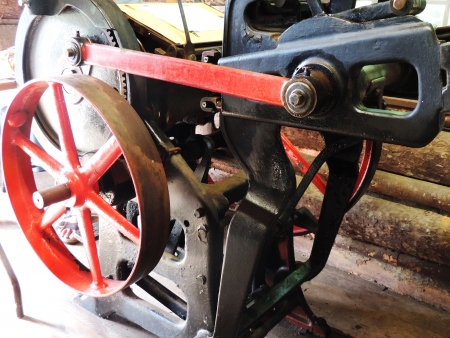
Q. You’ve used letterpress at Princeton, right? In what ways has it informed your teaching there?
A. Bread Loaf’s Printer’s Cabin energized my efforts at the English Department at Princeton. Here too we had a huge interest among faculty—from poets, in particular—as well as from colleagues and graduate students whose interests ranged from the Renaissance to media studies. While the university did offer design classes through visual arts, we didn’t really have anything going in book studies per se. So I put together graduate workshops in letterpress at the studio of David Sellers of Pied Oxen Printers in nearby Hopewell, New Jersey. These workshops combined the history of the book and the basics of letterpress printing. Together we produced a handsome chapbook containing poems by faculty and student poets in the department. We will continue these workshops in the future. Having hands-on experience with letterpress has made me think more about the mammoth achievement of, say, Samuel Johnson’s Dictionary of the English Language. Similarly, Samuel Richardson and Benjamin Franklin were printers, and their profession deeply shaped what and how they wrote. Letterpress not only helps me think about the history of the book (which is important enough) but also about how writers themselves interact with the material aspects of their books. Having set poetry by hand, for example, I am now much more aware of the depth and dimensionality of poetry, its weight and substance.
Q. Could you describe your interest in restoring the presses at Bread Loaf, and your engagement in the project over this past year?
A. I’m a traditional literary scholar, and I’ve worked in textual studies as well as literary history. Obviously I realized that the printing presses at Bread Loaf were a treasure right in our backyard. I coordinated the work of students, alums, and faculty who shared this enthusiasm and were eager to help. I did my share of cleaning, and I ordered some equipment, but mostly I simply kept the ball rolling. A major part of making something like this happen is putting people in touch with each other and coordinating their efforts. This wasn’t difficult because so many people shared a sense of excitement about bringing letterpress printing back to the cabin and making this new program grow. It has really been gratifying to be a part of this.
Q. What kind of letterpress-related programming and activities do you anticipate for the coming years at Bread Loaf?
A. From the start, we wanted programming to grow spontaneously with the needs and interests of our community. Already that has happened. Next year, we plan to have weekly workshops with Heather Hale, Sally Foster, and John Vincent offering steady guidance for those who want to learn the practice of printing. Additionally, some faculty are already planning to use trips to the Printer’s Cabin in their courses. Others have expressed interest in papermaking, binding, and allied book arts. So the curriculum is adjusting to this new resource. I’d also like to think about how we can print material of interest and value to the entire community.
Q. Would you like to make any other comments about the success of the letterpress initiative and initial programming this summer?
A. First, I’d just like to observe that letterpress is making a real comeback, in the academy and outside of it. Some people credit Martha Stewart herself with popularizing the beauty of hand-printed wedding invitations and the like for general audiences. At colleges and universities, I think, students turn readily to letterpress printing as an alternative to on-screen, virtual print, which has no real dimension or feel. For me as a teacher, this introduces a new way of getting students to slow down, to think about detail, and to take pride in the preparation of their work.
econd, I want to thank a lot of people. I’d like to thank BLSE Director Emily Bartels for all her help with programming and resources; BLSE Associate Director Tyler Curtain for his support and enthusiasm; Rebekah Irwin of Special Collections for her ideas about widening the appeal of letterpress beyond Bread Loaf; Mark Wright MA ’89 for providing a lot of manpower and expertise in the early stages of readying the cabin; Bread Loaf faculty member Gwyneth Lewis for contributing marvelous poems for the letterpress workshops to work on and with; and all the other Bread Loaf staff, faculty, students, and alums who made this happen.
